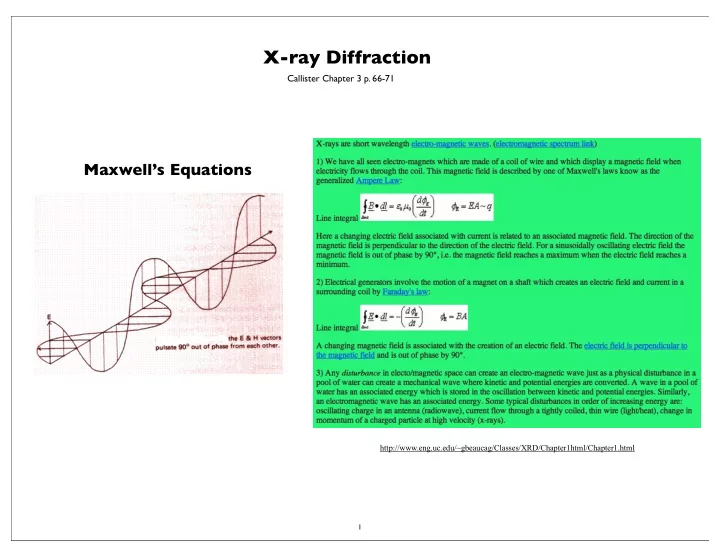

X-ray Diffraction Callister Chapter 3 p. 66-71 Maxwell’s Equations http://www.eng.uc.edu/~gbeaucag/Classes/XRD/Chapter1html/Chapter1.html 1
2
The Binary Scattering Event I(2 θ ) = N n e2 n e Reflects the density of a Point generating waves N is total number of points Why would N and n e change with (2 θ )? 3
Binary Interference Yields Scattering Pattern. -Consider that a wave scattered at an angle 2 θ was in phase with the incident wave at the source of scattering -This can occur for points separated by r such that r is called the scattering vector and the scattering elements (atoms) must be located at the ends of the scattering vector for a diffraction event to occur 4
The length of r changes with 2 θ The minimum of r is λ /2 and the maximum is ∞ r points in a direction normal to θ This means that crystallographic planes must be arranged at the angle θ for diffraction to occur Small 2 θ yields large r Large 2 θ yields small r r has a direction roughly normal to the propagating beam (it bisects 2 θ ) 5
For a lattice that matches r in size and orientation we get a diffraction event 6
r points in a direction normal to θ This means that crystallographic planes must be arranged at the angle θ for diffraction to occur This is called the specular (mirror-like) analogy, the plane seems to act like a mirror ( the plane is not a mirror and there is no reflection, this is an interference phenomena ) Planes in Black X-ray Beam in Green Small 2 θ yields large r Large 2 θ yields small r r has a direction roughly normal to the propagating beam (it bisects 2 θ ) 7
Bragg’s Law defines the angle 2 θ of diffraction for a plane with d-spacing d (hkl) λ /2 is the smallest size that can be measured At small angle d goes to ∞ The function depends on θ not 2 θ Since d is inverse to the sin of the angle we call the diffraction space “inverse space” it is also called momentum space (for other reasons) In a 2D or 1D diffraction pattern large distances from the beam center correspond to small “d” and large distances correspond to large “d” Another feature in inverse space are the Miller Indices Large unit cell indices correspond to small unit cell distances Small indices correspond to large unit cell distances The Miller Indices are vectors in inverse space. (i.e. in the diffraction pattern) Also, directions are orthogonal (right angles) We will look at this later 8
Derive Bragg’s Law Following the Specular Analogy θ θ Planes in Black X-ray Beam in Green Add Bisector θ θ Add Normal to For constructive interference the extra distance Beam to get traveled must equal a multiple of λ Extra distance traveled θ n λ = 2 d sin θ θ n = 1 for x-ray diffraction from 3d crystals Extract Right Triangle and Solve for Distance Δ x = d sin θ θ d The total extra distance is twice this: 2 d sin θ Δ x 9
What is needed to get an x-ray peak: 1) 2 θ , λ and d hkl must meet Bragg’s Condition 2) (hkl) plane must be aligned in the specular condition Plane that meets (1) must be at an angle θ to the incident beam 3) The plane must be oriented in the aziumthal angle so that the diffraction peak falls on the detector (for a single channel detector) Normally for a single crystal with a monchromatic source it is unlikely that all three of these conditions will be met There are two common ways to overcome this limitation 1) Grind the single crystal into a powder so that all possible orientations will be present Overcoming 2) and 3) Used for grainy metals, polymers, most diffraction experiments in Materials Science. 2) Use polychromatic radiation so that most reflections will be observed Overcoming 1) Laue Pattern/Laue Method (Used for Protein Crystals/Silicon Alignment/Gem Stones) 10
Diffraction from a perfect crystal (Laue Method) Polychromatic 11
Diffraction from a Powder Powder Pattern (Debye-Scherrer Method) Ground up Sugar Sugar (Debye-Scherrer Rings) Monochromatic 12
Orientation (Polyethylene) Highly Oriented Unoriented Polymers have broad Debye-Scherrer Rings 13
Orientation Aluminum and Graphite Aluminum Foil Graphite 14
Diffractometer Scans (Single Channel Detector) Lead (FCC) Nickel (FCC) 15
Tungsten (BCC) Lead (FCC) Zinc (HCP) 16
What is an Amorphous Halo? Liquid Water 17
What is Scherrer Broadening? Size of the crystal, t, decreases as the breadth of the peak, B, increases ( B is in radians for this to work ) What other kinds of peak broadening occur? Residual Stress in the crystal causes broadening Debye Thermal Broadening caused by thermal motion of the atoms (Used to measure heat capacity) 18
What can we measure from diffraction? Size: d-spacing, RMS distance for Amorphous Composition: Alloys, Blends, DOC for Polymers Grain size sub-micron scale (Nanocrystal size) Residual Stress Heat Capacity/Mean Free Path of Atoms Grain size super-micron scale Orientation of Crystals Thermal Expansion Coefficient for Lattice Parameters What can’t we measure from diffraction? No Picture of the Crystal No Real-Space Image 19
Recommend
More recommend